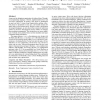Free Online Productivity Tools
i2Speak
i2Symbol
i2OCR
iTex2Img
iWeb2Print
iWeb2Shot
i2Type
iPdf2Split
iPdf2Merge
i2Bopomofo
i2Arabic
i2Style
i2Image
i2PDF
iLatex2Rtf
Sci2ools
PLDI
2010
ACM
2010
ACM
Z-rays: divide arrays and conquer speed and flexibility
Arrays are the ubiquitous organization for indexed data. Throughout programming language evolution, implementations have laid out arrays contiguously in memory. This layout is problematic in space and time. It causes heap fragmentation, garbage collection pauses in proportion to array size, and wasted memory for sparse and over-provisioned arrays. Because of array virtualization in managed languages, an array layout that consists of indirection pointers to fixed-size discontiguous memory blocks can mitigate these problems transparently. This design however incurs significant overhead, but is justified when real-time deadlines and space constraints trump performance. This paper proposes z-rays, a discontiguous array design with flexibility and efficiency. A z-ray has a spine with indirection pointers to fixed-size memory blocks called arraylets, and uses five optimizations: (1) inlining the first N array bytes into the spine, (2) lazy allocation, (3) zero compression, (4) fast ...
| Added | 10 Jul 2010 |
| Updated | 10 Jul 2010 |
| Type | Conference |
| Year | 2010 |
| Where | PLDI |
| Authors | Jennifer B. Sartor, Stephen M. Blackburn, Daniel Frampton, Martin Hirzel, Kathryn S. McKinley |
Comments (0)

